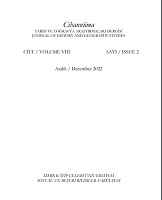ÜSKÜDAR’DA OSMANLI MEDRESE GELENEĞİNİN GELİŞİMİ VE MİHRİMAH SULTAN MÜDERRİSLERİ: ULEMA BİYOGRAFİ ESERLERİ VE RUZNAMÇE KAYITLARI ÜZERİNE BİR DEĞERLENDİRME (1547-1732)
THE DEVELOPMENT OF THE OTTOMAN MADRASA TRADITION IN ÜSKÜDAR AND MIHRIMAH SULTAN MUDARRISES: AN EVALUATION ON BOOKS OF ULEMA BIOGRAPHIES AND RUZNAMÇE REGISTERS (1547- 1732)
Author(s): Esra MuhacırSubject(s): Cultural Anthropology / Ethnology, 16th Century, 17th Century, 18th Century, The Ottoman Empire, Sociology of Education
Published by: İzmir Kâtip Çelebi Üniversitesi, Sosyal ve Beşeri Bilimler Fakültesi
Keywords: Üsküdar; Mihrimah Sultan Madrasa; Mudarris and Kadis’s Careers;
Summary/Abstract: Foundations, which have been established for centuries, were an important factor in the development of the city and culture in Üsküdar. Mosques, masjids, madrasahs, dervish lodges and soup kitchens built through foundations provided the physical and economic development of the city, thus, these structures brought about an increase in population. Especially kulliye-type structures have made a great contribution to the economic, social and cultural development of cities. Madrasas in kulliyes responded to the educational needs of the city and created an educated class. In the history of Üsküdar education, madrasas were the most important tools of cultural and intellectual development. In this context, the formation of the madrasah tradition in Üsküdar began with the establishment of the Rum Mehmed Pasha Madrasa as the first madrasah. Later it continued with Abdullah Ağa and Mihrimah Sultan Madrasahs. Mihrimah Sultan Madrasa in Üsküdar has a significant place in the history of culture and education, as an institution that employed a significant number of mudarris for the history of Üsküdar from the middle of the 16th century to the 18th century. In this process, the mudarrises who lectured in the madrasah were examined based on the Şakayık-ı Numaniye and its annexes. The biographies of mudarrises, which were not included in the literature before, were determined through the Ruznamçe records and added to the literature. We can determine through the various sources, the first mudarris appointment begins in 1547, after the completion of the kulliye, and continues to 1732. In this study, the biographies of 185 mudarris who lectured in Mihrimah Sultan Madrasa from the 16th century to the middle of the 18th century were examined, and their career steps that developed as mudarris, mufti, kadi, cadilesker and sheikh al-Islam were evaluated.
Journal: Cihannüma: Tarih ve Coğrafya Araştırmaları Dergisi
- Issue Year: VIII/2022
- Issue No: 2
- Page Range: 71-114
- Page Count: 44
- Language: Turkish

